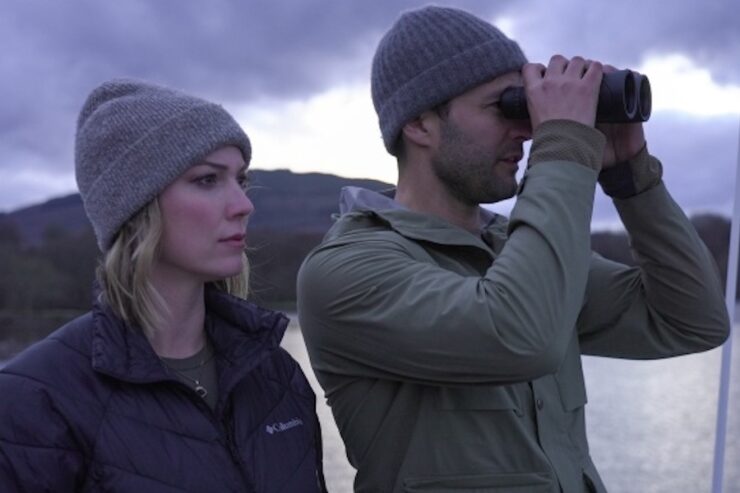While I was working my through Peter Costello’s In Search of Lake Monsters, I happened across the new season of Expedition X, which just dropped. Lo and behold, episode 3 explores “What Lurks in Loch Ness.” Josh Gates intones, “Is the most iconic monster of them all about to be discovered?” And we’re off on a monster hunt.
It seems there’s new evidence, and Nessie hunters are excited. It’s a series of photos taken by amateur photographer Chie Kelly from the Dores Inn in Inverness in 2018, but she kept them to herself until 2023 for fear of ridicule (which is a frequent explanation for delays in releasing paranormal or controversial evidence). Nessie expert Steven Feltham professed himself thrilled, saying it’s some of the best evidence that’s ever been found.
But there’s more! Which the episode will get to in a minute. To start with, Gates meets with his team in New York. Phil and Heather—wait.
Oh yes. Jess has left the show. Now we have third-generation paranormal researcher and true believer Heather. Her energy is pretty similar and she bounces off Phil in much the same way. Phil continues to be his skeptical scientific self, but he’s excited by this assignment, too. He gets to investigate the mother of all lake monsters, and he gets to use the cool tools.
The photos are extremely interesting, because they’re classic Nessie. For once we can see in detail what numerous witnesses have described. Bubbling water, dark humps, no head or tail showing. One shot looks like a pair of gleaming silver snakelike coils. They validate decades of sightings, though what they are is the question.
We get a quick summary of the history of sightings. A key point, which Costello also makes, is that in 1933 a road went through by the loch, and that’s when the sightings—and the photos and videos—started. There are legends all the way back to St. Columba, but the point at which it all went viral was the arrival of the road.
One of Phil’s suggestions is that the monster is actually a fish. Specifically, a Wels catfish. These fish are huge, they’re about the right color and shape, and they have barbels on their faces, which might explain the mane or the horns of the Nessie sightings. Feltham thinks that’s a possibility, too. It was introduced to the lake in the nineteenth century as a sport fish, so it’s not entirely improbable.
Phil and Heather do their due diligence, speaking to witnesses including Feltham, and trying to debunk the Kelly photos. Phil suspects it may have been a diver throwing off bubbles, though there was no boat in sight for the diver to have been working from. He stations Heather on shore with a camera similar to Kelly’s, but the results don’t duplicate hers.
The locals not only detail their sightings (some of which have had multiple witnesses). They also mention that there are caves under the loch, which might provide hiding places for the cryptid and—this is a crucial point—offer breeding and nursery spaces for a colony. Phil is keen to investigate these.
Meanwhile, they pull out the cool tools, including an underwater camera capable of recording at great depths, and a hydrophone to capture sounds—because another thing witnesses have recorded are weird, whale-like noises in the loch. Feltham is even more excited about his sonar discovery than Kelly’s photos. That shows something down at the bottom of the loch, which is basically shaped like a bathtub with steep sides. Way down there, he’s recorded something about thirty feet long. That’s bigger than the biggest known Wels catfish.
Phil does two things about the caves. He takes an eDNA kit to one of the caves’ possible outlets and samples the water, and he suits up and dives into what he thinks may be a trench. Meanwhile Heather captures the whale-like sound in the loch, and the camera, called Deep Trekker, finds something down there that hides itself in silt. It also finds eels. Many eels. (I.e., food for a large predator.)
It’s all very exciting, but this is a cryptid, so it’s also, well, cryptic. The trench turns out to be “a typical 30-foot lake shelf.” The sounds are probably methane released from the bottom, which is kind of a bummer but also kind of cool. The object on the sonar checks out to be about 20 feet long, and seems to be some kind of aquatic creature, though what it is, there’s no way to determine.
The caves may or may not be real. Phil doesn’t find conclusive proof. The eDNA finds a number of fish species, and—excitement!—something “unexpected,” i.e., not in the database. The lab points out that it might be a sampling glitch.
Still. Maybe it’s not. We want to believe. Don’t we?










